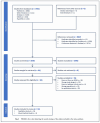Shared Decision-Making for Patients with Stroke in Neurocritical Care: A Qualitative Meta-Synthesis
- PMID: 39192102
- PMCID: PMC11950011
- DOI: 10.1007/s12028-024-02106-y
Shared Decision-Making for Patients with Stroke in Neurocritical Care: A Qualitative Meta-Synthesis
Abstract
Decision-making for patients with stroke in neurocritical care is uniquely challenging because of the gravity and high preference sensitivity of these decisions. Shared decision-making (SDM) is recommended to align decisions with patient values. However, limited evidence exists on the experiences and perceptions of key stakeholders involved in SDM for neurocritical patients with stroke. This review aims to address this gap by providing a comprehensive analysis of the experiences and perspectives of those involved in SDM for neurocritical stroke care to inform best practices in this context. A qualitative meta-synthesis was conducted following the methodological guidelines of the Joanna Briggs Institute (JBI), using the thematic synthesis approach outlined by Thomas and Harden. Database searches covered PubMed, CIHAHL, EMBASE, PsycINFO, and Web of Science from inception to July 2023, supplemented by manual searches. After screening, quality appraisal was performed using the JBI Appraisal Checklist. Data analysis comprised line-by-line coding, development of descriptive themes, and creation of analytical themes using NVivo 12 software. The initial search yielded 7,492 articles, with 94 undergoing full-text screening. Eighteen articles from five countries, published between 2010 and 2023, were included in the meta-synthesis. These studies focused on the SDM process, covering life-sustaining treatments (LSTs), palliative care, and end-of-life care, with LST decisions being most common. Four analytical themes, encompassing ten descriptive themes, emerged: prognostic uncertainty, multifaceted balancing act, tripartite role dynamics and information exchange, and influences of sociocultural context. These themes form the basis for a conceptual model offering deeper insights into the essential elements, relationships, and behaviors that characterize SDM in neurocritical care. This meta-synthesis of 18 primary studies offers a higher-order interpretation and an emerging conceptual understanding of SDM in neurocritical care, with implications for practice and further research. The complex role dynamics among SDM stakeholders require careful consideration, highlighting the need for stroke-specific communication strategies. Expanding the evidence base across diverse sociocultural settings is critical to enhance the understanding of SDM in neurocritical patients with stroke.Trial registration This study is registered with PROSPERO under the registration number CRD42023461608.
Keywords: Critical care; Qualitative research; Shared decision-making; Stroke.
© 2024. The Author(s).
Conflict of interest statement
Conflict of interest: The authors declare no conflicts of interest.
Figures


Similar articles
-
Health professionals' experience of teamwork education in acute hospital settings: a systematic review of qualitative literature.JBI Database System Rev Implement Rep. 2016 Apr;14(4):96-137. doi: 10.11124/JBISRIR-2016-1843. JBI Database System Rev Implement Rep. 2016. PMID: 27532314
-
Can We Enhance Shared Decision-making for Periacetabular Osteotomy Surgery? A Qualitative Study of Patient Experiences.Clin Orthop Relat Res. 2025 Jan 1;483(1):120-136. doi: 10.1097/CORR.0000000000003198. Epub 2024 Jul 23. Clin Orthop Relat Res. 2025. PMID: 39051876
-
The experience of adults who choose watchful waiting or active surveillance as an approach to medical treatment: a qualitative systematic review.JBI Database System Rev Implement Rep. 2016 Feb;14(2):174-255. doi: 10.11124/jbisrir-2016-2270. JBI Database System Rev Implement Rep. 2016. PMID: 27536798
-
Shared decision-making interventions for people with mental health conditions.Cochrane Database Syst Rev. 2022 Nov 11;11(11):CD007297. doi: 10.1002/14651858.CD007297.pub3. Cochrane Database Syst Rev. 2022. PMID: 36367232 Free PMC article.
-
Experiences of gynecological cancer patients receiving care from specialist nurses: a qualitative systematic review.JBI Database System Rev Implement Rep. 2017 Aug;15(8):2087-2112. doi: 10.11124/JBISRIR-2016-003126. JBI Database System Rev Implement Rep. 2017. PMID: 28800057
References
-
- Tsao CW, Aday AW, Almarzooq ZI, et al. Heart disease and stroke statistics—2022 update: a report from the American Heart Association. Circulation. 2022;145(8):e153–639. - PubMed
-
- Busl KM, Bleck TP, Varelas PN. Neurocritical care outcomes, research, and technology: a review. JAMA Neurol. 2019;76(5):612–8. - PubMed
-
- Goostrey K, Muehlschlegel S. Prognostication and shared decision making in neurocritical care. BMJ. 2022;377:e060154. - PubMed
Publication types
MeSH terms
Grants and funding
LinkOut - more resources
Full Text Sources
Medical
Miscellaneous

